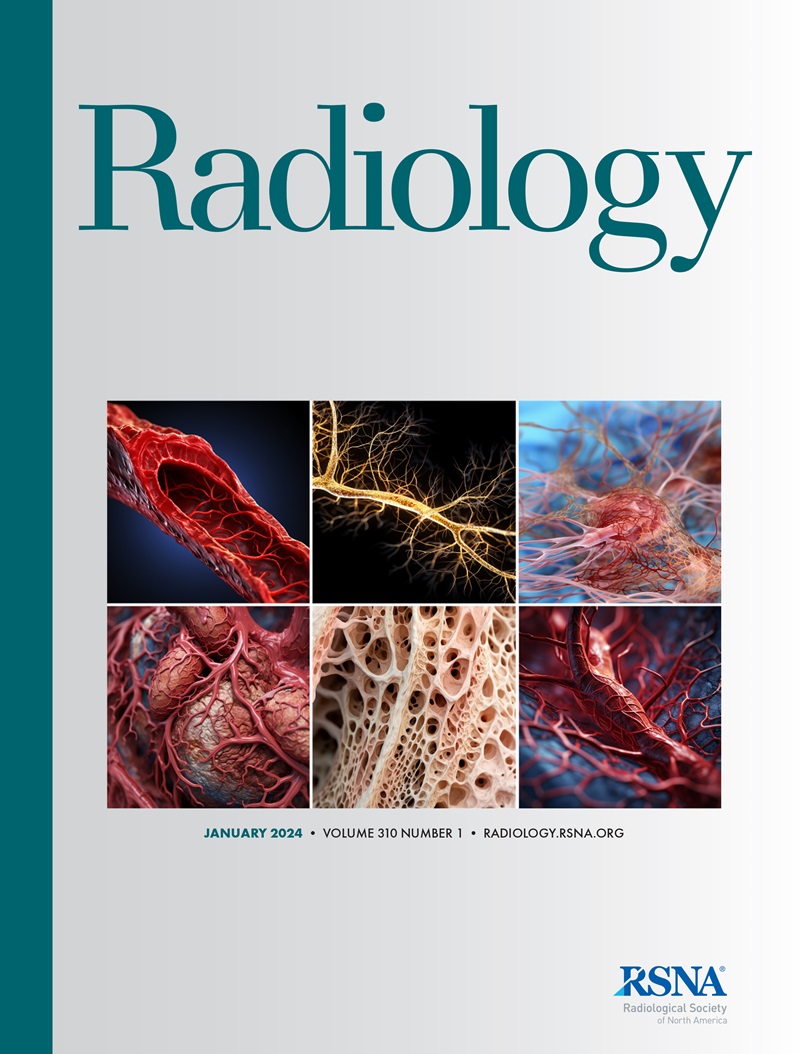Pritam Mukherjee, Benjamin Hou, Abhinav Suri, Yan Zhuang, Christopher Parnell, Nicholas Lee, Oana Stroie, Ravi Jain, Kenneth C Wang, Komal Sharma, Ronald M Summers
下载PDF
{"title":"在 RSNA 2023 \"每日案例 \"问题上评估 GPT 大语言模型性能。","authors":"Pritam Mukherjee, Benjamin Hou, Abhinav Suri, Yan Zhuang, Christopher Parnell, Nicholas Lee, Oana Stroie, Ravi Jain, Kenneth C Wang, Komal Sharma, Ronald M Summers","doi":"10.1148/radiol.240609","DOIUrl":null,"url":null,"abstract":"<p><p>Background GPT-4V (GPT-4 with vision, ChatGPT; OpenAI) has shown impressive performance in several medical assessments. However, few studies have assessed its performance in interpreting radiologic images. Purpose To assess and compare the accuracy of GPT-4V in assessing radiologic cases with both images and textual context to that of radiologists and residents, to assess if GPT-4V assistance improves human accuracy, and to assess and compare the accuracy of GPT-4V with that of image-only or text-only inputs. Materials and Methods Seventy-two Case of the Day questions at the RSNA 2023 Annual Meeting were curated in this observer study. Answers from GPT-4V were obtained between November 26 and December 10, 2023, with the following inputs for each question: image only, text only, and both text and images. Five radiologists and three residents also answered the questions in an \"open book\" setting. For the artificial intelligence (AI)-assisted portion, the radiologists and residents were provided with the outputs of GPT-4V. The accuracy of radiologists and residents, both with and without AI assistance, was analyzed using a mixed-effects linear model. The accuracies of GPT-4V with different input combinations were compared by using the McNemar test. <i>P</i> < .05 was considered to indicate a significant difference. Results The accuracy of GPT-4V was 43% (31 of 72; 95% CI: 32, 55). Radiologists and residents did not significantly outperform GPT-4V in either imaging-dependent (59% and 56% vs 39%; <i>P</i> = .31 and .52, respectively) or imaging-independent (76% and 63% vs 70%; both <i>P</i> = .99) cases. With access to GPT-4V responses, there was no evidence of improvement in the average accuracy of the readers. The accuracy obtained by GPT-4V with text-only and image-only inputs was 50% (35 of 70; 95% CI: 39, 61) and 38% (26 of 69; 95% CI: 27, 49), respectively. Conclusion The radiologists and residents did not significantly outperform GPT-4V. Assistance from GPT-4V did not help human raters. GPT-4V relied on the textual context for its outputs. © RSNA, 2024 <i>Supplemental material is available for this article.</i> See also the editorial by Katz in this issue.</p>","PeriodicalId":20896,"journal":{"name":"Radiology","volume":"313 1","pages":"e240609"},"PeriodicalIF":15.2000,"publicationDate":"2024-10-01","publicationTypes":"Journal Article","fieldsOfStudy":null,"isOpenAccess":false,"openAccessPdf":"https://www.ncbi.nlm.nih.gov/pmc/articles/PMC11535869/pdf/","citationCount":"0","resultStr":"{\"title\":\"Evaluation of GPT Large Language Model Performance on RSNA 2023 Case of the Day Questions.\",\"authors\":\"Pritam Mukherjee, Benjamin Hou, Abhinav Suri, Yan Zhuang, Christopher Parnell, Nicholas Lee, Oana Stroie, Ravi Jain, Kenneth C Wang, Komal Sharma, Ronald M Summers\",\"doi\":\"10.1148/radiol.240609\",\"DOIUrl\":null,\"url\":null,\"abstract\":\"<p><p>Background GPT-4V (GPT-4 with vision, ChatGPT; OpenAI) has shown impressive performance in several medical assessments. However, few studies have assessed its performance in interpreting radiologic images. Purpose To assess and compare the accuracy of GPT-4V in assessing radiologic cases with both images and textual context to that of radiologists and residents, to assess if GPT-4V assistance improves human accuracy, and to assess and compare the accuracy of GPT-4V with that of image-only or text-only inputs. Materials and Methods Seventy-two Case of the Day questions at the RSNA 2023 Annual Meeting were curated in this observer study. Answers from GPT-4V were obtained between November 26 and December 10, 2023, with the following inputs for each question: image only, text only, and both text and images. Five radiologists and three residents also answered the questions in an \\\"open book\\\" setting. For the artificial intelligence (AI)-assisted portion, the radiologists and residents were provided with the outputs of GPT-4V. The accuracy of radiologists and residents, both with and without AI assistance, was analyzed using a mixed-effects linear model. The accuracies of GPT-4V with different input combinations were compared by using the McNemar test. <i>P</i> < .05 was considered to indicate a significant difference. Results The accuracy of GPT-4V was 43% (31 of 72; 95% CI: 32, 55). Radiologists and residents did not significantly outperform GPT-4V in either imaging-dependent (59% and 56% vs 39%; <i>P</i> = .31 and .52, respectively) or imaging-independent (76% and 63% vs 70%; both <i>P</i> = .99) cases. With access to GPT-4V responses, there was no evidence of improvement in the average accuracy of the readers. The accuracy obtained by GPT-4V with text-only and image-only inputs was 50% (35 of 70; 95% CI: 39, 61) and 38% (26 of 69; 95% CI: 27, 49), respectively. Conclusion The radiologists and residents did not significantly outperform GPT-4V. Assistance from GPT-4V did not help human raters. GPT-4V relied on the textual context for its outputs. © RSNA, 2024 <i>Supplemental material is available for this article.</i> See also the editorial by Katz in this issue.</p>\",\"PeriodicalId\":20896,\"journal\":{\"name\":\"Radiology\",\"volume\":\"313 1\",\"pages\":\"e240609\"},\"PeriodicalIF\":15.2000,\"publicationDate\":\"2024-10-01\",\"publicationTypes\":\"Journal Article\",\"fieldsOfStudy\":null,\"isOpenAccess\":false,\"openAccessPdf\":\"https://www.ncbi.nlm.nih.gov/pmc/articles/PMC11535869/pdf/\",\"citationCount\":\"0\",\"resultStr\":null,\"platform\":\"Semanticscholar\",\"paperid\":null,\"PeriodicalName\":\"Radiology\",\"FirstCategoryId\":\"3\",\"ListUrlMain\":\"https://doi.org/10.1148/radiol.240609\",\"RegionNum\":1,\"RegionCategory\":\"医学\",\"ArticlePicture\":[],\"TitleCN\":null,\"AbstractTextCN\":null,\"PMCID\":null,\"EPubDate\":\"\",\"PubModel\":\"\",\"JCR\":\"Q1\",\"JCRName\":\"RADIOLOGY, NUCLEAR MEDICINE & MEDICAL IMAGING\",\"Score\":null,\"Total\":0}","platform":"Semanticscholar","paperid":null,"PeriodicalName":"Radiology","FirstCategoryId":"3","ListUrlMain":"https://doi.org/10.1148/radiol.240609","RegionNum":1,"RegionCategory":"医学","ArticlePicture":[],"TitleCN":null,"AbstractTextCN":null,"PMCID":null,"EPubDate":"","PubModel":"","JCR":"Q1","JCRName":"RADIOLOGY, NUCLEAR MEDICINE & MEDICAL IMAGING","Score":null,"Total":0}
引用次数: 0
引用
批量引用

 求助内容:
求助内容: 应助结果提醒方式:
应助结果提醒方式:


